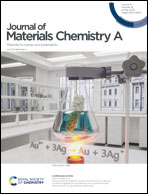Unveiling the solid-solution charge storage mechanism in 1T vanadium disulfide nanoarray cathodes†
Abstract
Transition metal disulfides (TMDs) have achieved intensive attention in the field of energy storage materials owing to their natural layered structures. However, most TMDs are in the semiconductor phase with inferior electrical conductivity, which has prevented their widespread applications. The 1T-phase vanadium disulfide, in contrast, exhibits some metal characteristic qualities, which enable it to be a superb intercalation host material for Li-ion batteries. We herein demonstrate high rate capability, and the capacity retention can achieve 84.4% after 1000 cycles. In situ synchrotron X-ray diffraction (XRD) results reveal that the VS2 electrode exhibits a typical solid solution reaction, which is of great help in inhibiting the structural transition. Density functional theory (DFT) calculations further indicate that the monolayer 1T-phase VS2 can withstand the high lithiation rate without structural changes and possesses a lower energy barrier with unrestricted diffusion pathways. This work is quite significant and reliable for the subsequent study on two-dimensional materials.



 Please wait while we load your content...
Please wait while we load your content...